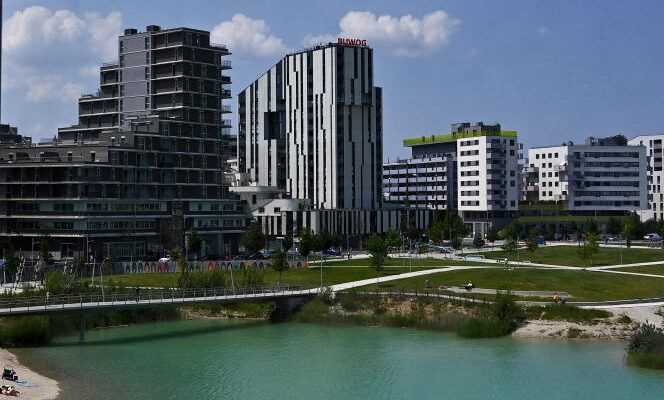The words are written on huge gray panels, overlooking the lake: Frauen bauen Stadt, “Women build the city”. Erica and Lucas Hofer, a couple in their thirties, take a distracted look from the Janis-Joplin promenade, where they are scouting. “Here, all the streets are named after women”, remarks Lucas, an engineer by profession. “But that’s not why we would like to move to Aspern Seestadt”, adds his partner, also an engineer. A little further on, they go up rue Maria-Tusch, wide and bright, with no difference in level between the sidewalk and the roadway. Near the entrance halls, spaces are designed to accommodate bicycles, strollers, wheelchairs and toys. “And wait until you see the rest”, Lucas enthuses, already imagining to put his suitcases here.
Nurseries, shops, offices, coworking spaces at the foot of buildings: in Aspern Seestadt, everything has been designed so that women, as well as men, can enjoy the public space, but also better reconcile professional and personal life . This 240 hectare district on the outskirts of Vienna, at the end of metro line 2, is one of the most ambitious urban development projects in Europe. Nine thousand people already live there. In 2030, they will be 30,000. “The whole is built according to the latest environmental criteria and a gender-sensitive approach”, details Wolfgang Gerlich, of PlanSinn, an urban planning firm supporting the project.
Gender sensitive approach, or gender mainstreaming, in English: Vienna is one of the pioneering cities of this approach advocated by the United Nations since 1995. “It is a strategy to incorporate the concerns and experiences of women as well as those of men in the formulation, implementation and evaluation of policies in all areas – political, economic and social., explains the institution, on its Web site devolved on this subject. The ultimate goal is to achieve gender equality. “
At first glance, this may seem somewhat removed from town planning and the daily issues managed by town halls. “But in truth, we are at the heart of the matter: Vienna, like most European cities, was designed by and for men”, explains architect Sabina Riss, who studies the relationship between urban planning and gender at the Technical University of Vienna. Understand: mobility, streets, neighborhoods have been designed primarily for home-work journeys, neglecting other times of the day. Namely those devoted to bringing children to school, shopping, home care, visits to elderly parents … So many tasks still mainly carried out by women, even if the lines are moving.
You have 72.28% of this article to read. The rest is for subscribers only.
